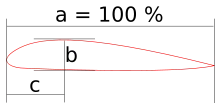Thickness-to-chord ratio
In aeronautics, the thickness-to-chord ratio, sometimes simply chord ratio or thickness ratio, compares the maximum vertical thickness of a wing to its chord. It is a key measure of the performance of a wing planform when it is operating at transonic speeds.


At speeds approaching the speed of sound, the effects of Bernoulli's principle over curves on the wing and fuselage can accelerate the local flow to supersonic speeds. This creates a shock wave that produces a powerful form of drag known as wave drag, and gives rise to the concept of the sound barrier. The speed at which these shocks first form, critical mach, is a function of the amount of curvature. In order to reduce wave drag, wings should have the minimum curvature possible while still generating the required amount of lift. So, the main reason for decreasing the blade section thickness to chord ratio is to delay the compressibility effect related to higher Mach numbers, delaying the onset of a shock wave formation.
The natural outcome of this requirement is a wing design that is thin and wide, which has a low thickness-to-chord ratio. At lower speeds, undesirable parasitic drag is largely a function of the total surface area, which suggests using a wing with minimum chord, leading to the high aspect ratios seen on light aircraft and regional airliners. Such designs naturally have high thickness-to-chord ratios. Designing an aircraft that operates across a wide range of speeds, like a modern airliner, requires these competing needs to be carefully balanced for every aircraft design.
Swept wings are a practical outcome of the desire to have a low thickness-to-chord ratio at high speeds and a lower one at lower speeds during takeoff and landing. The sweep stretches the chord as seen by the airflow, while still keeping the wetted area of the wing to a minimum. For practical reasons, wings tend to be thickest at the root, where they meet the fuselage. For this reason, it is common for wings to taper their chord towards the tips, keeping the thickness-to-chord ratio close to constant, this also reduces induced drag at lower speeds. The crescent wing is another solution to the design to keep a relatively constant thickness-to-chord ratio.
| Airliners[1] | Area (m²) |
Span (m) |
Aspect Ratio |
Taper Ratio |
Average (t/c) % |
1/4 Chord Sweep (°)" |
|---|---|---|---|---|---|---|
| ERJ 145 | 51.18 | 20.04 | 7.85 | 0.231 | 11.00 | 22.73 |
| CRJ100 | 54.54 | 20.52 | 7.72 | 0.288 | 10.83 | 24.75 |
| Avro RJ | 77.30 | 26.21 | 8.89 | 0.356 | 12.98 | 15.00 |
| 737 Original/Classic | 91.04 | 28.35 | 8.83 | 0.266 | 12.89 | 25.00 |
| DC-9 | 92.97 | 28.47 | 8.72 | 0.206 | 11.60 | 24.00 |
| Boeing 717 | 92.97 | 28.40 | 8.68 | 0.196 | 11.60 | 24.50 |
| Fokker 100/70 | 93.50 | 28.08 | 8.43 | 0.235 | 10.28 | 17.45 |
| MD-80/90 | 112.30 | 32.87 | 9.62 | 0.195 | 11.00 | 24.50 |
| A320 | 122.40 | 33.91 | 9.39 | 0.240 | 11.92[2] | 25.00 |
| 737 NG | 124.60 | 34.30 | 9.44 | 0.278 | 25.00 | |
| Boeing 727 | 157.90 | 32.92 | 6.86 | 0.309 | 11.00 | 32.00 |
| Boeing 757 | 185.25 | 38.05 | 7.82 | 0.243 | 25.00 | |
| A310 | 219.00 | 43.89 | 8.80 | 0.283 | 11.80 | 28.00 |
| A300 | 260.00 | 44.84 | 7.73 | 0.300 | 10.50 | 28.00 |
| DC-8 | 271.90 | 45.23 | 7.52 | 0.181 | 11.00 | 30.00 |
| Boeing 767 | 283.30 | 47.57 | 7.99 | 0.207 | 11.50 | 31.50 |
| Boeing 707 | 283.40 | 44.42 | 6.96 | 0.259 | 10.00 | 35.00 |
| MD-11 | 338.90 | 51.77 | 7.91 | 0.239 | 9.35 | 35.00 |
| A330/A340-200/300 | 363.10 | 58.00 | 9.26 | 0.251 | 11.80[2] | 29.70 |
| DC-10 | 367.70 | 50.40 | 6.91 | 0.220 | 11.00 | 35.00 |
| Boeing 777 | 427.80 | 60.90 | 8.67 | 0.149 | 31.60 | |
| A340-500/600 | 437.30 | 61.20 | 8.56 | 0.220 | 31.10 | |
| 747 Classic | 511.00 | 59.64 | 6.96 | 0.284 | 9.40 | 37.50 |
| 747-400 | 525.00 | 62.30 | 7.39 | 0.275 | 9.40 | 37.50 |
| MD-12 | 543.00 | 64.92 | 7.76 | 0.215 | 35.00 | |
| A3XX | 817.00 | 79.80 | 7.79 | 0.213 | 30.00 |
References
- "Aircraft Data File". Civil Jet Aircraft Design. Elsevier. July 1999.
- Simona Ciornei (31 May 2005). "Mach number, relative thickness, sweep and lift coefficient of the wing - An empirical investigation of parameters and equations" (PDF). Hamburg University of Applied Sciences.
Further reading
- Andrianne, T. (2016). "Aerodynamics" (PDF). Université de Liège. pp. 49–50.